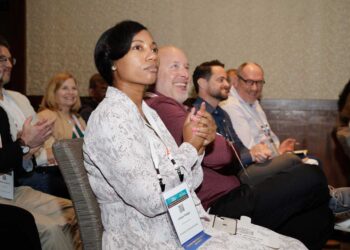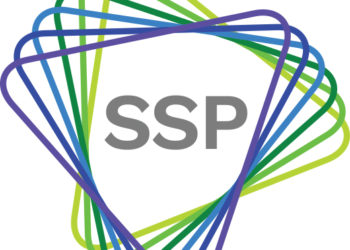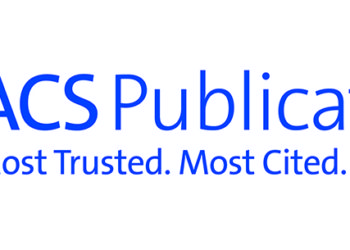 Having just “asked the fellows” about their impressions of the SSP Annual Meeting, it seemed appropriate to get the perspectives of librarians! Hillary Corbett, the Director of Scholarly Communication & Digital Publishing at Northeastern University, and Charlotte Roh, the Scholarly Communications Librarian at the University of San Francisco, graciously agreed to organize their thoughts for this post. Hillary has been no stranger to the SSP Annual Meeting, having attended twice previously. Charlotte was a first timer! We thank both Hillary and Charlotte for serving on the SSP Annual Meeting Program Committee this year and are looking forward to continuing to work with them in the future!
Having just “asked the fellows” about their impressions of the SSP Annual Meeting, it seemed appropriate to get the perspectives of librarians! Hillary Corbett, the Director of Scholarly Communication & Digital Publishing at Northeastern University, and Charlotte Roh, the Scholarly Communications Librarian at the University of San Francisco, graciously agreed to organize their thoughts for this post. Hillary has been no stranger to the SSP Annual Meeting, having attended twice previously. Charlotte was a first timer! We thank both Hillary and Charlotte for serving on the SSP Annual Meeting Program Committee this year and are looking forward to continuing to work with them in the future!
We asked Charlotte and Hillary: What Did You Learn At This Year’s SSP Annual Meeting?
They answered in a slightly different format than our usual “Ask The…” posts, let’s see what they had to say!
Charlotte Roh: I’m used to academic library conferences, so the SSP conference was a very different animal for me. I wasn’t expecting it to be so very much a business meeting, and so many of the conversations, particularly with exhibitors, weren’t relevant to me because 1) I’m not in a purchasing role in my small liberal arts institution and 2) in the words of John Willinsky in the closing panel, libraries are partnering rather than purchasing in order to publish.
That said, it was fascinating to me to see how much publishers are partnering, as many of the (fantastic!) sessions I attended had to do with metadata, standards, and interoperability. There was a lot less talk then I anticipated about how publishers were going to commodify open access (OA) and more talk about how publishers are going to work with the author and funder requirements around OA. So that tells me that the OA movement has reached certain maturity. That said, I did have a surreal experience where, in back-to-back conversations, someone told me that his employer was doing well and OA wasn’t going to hurt them, and then someone asked me, with real concern, what are all the academic societies going to do? How are they going to survive?
Hillary Corbett: I agree that the exhibits hall at SSP is geared very much towards publisher-vendor conversations. While libraries, including mine, are increasingly engaged in publishing activities, we are not the target audience for many of the services aimed at traditional publishers that I saw marketed at SSP. But that’s okay! One of the things I value most about attending SSP is the opportunity to have meaningful conversations with publishers and vendors, outside of a marketing context. And there were plenty of chances to do that this year.
I was very interested, for example, to learn about the efforts of several publishers and content providers to make their material accessible to researchers in the developing world. In the “Leveling the Global Playing Field” session, as well as a conversation with someone over breakfast, I gained some valuable insight into how providers are making their content freely available in specific parts of the world in support of equalizing accessibility while retaining their traditional subscription-based business model for most consumers.
Charlotte, you mentioned conversation about OA. In general, I think there was a lot less focus on OA this year than in some previous years (and a huge amount of attention given to standards and interoperability, as you say). This year, there were only three concurrent sessions (out of 27) and one pre-meeting seminar (out of six) at SSP that specifically called out OA in their titles or descriptions. I agree that most large scholarly publishers have accepted and operationalized OA in one way or another at this point, although those smaller society publishers still lag behind in uptake because subscriptions are an important component of their memberships.
As someone outside the world of traditional publishing, though, I think there are still important conversations to be had about OA — it’s not all figured out yet! In particular, I’d like to respond to something Joe Esposito cited as an SSP takeaway in the “Ask the Chefs” post: that the practices of libraries serve to stifle publisher innovation because we serve as the conduit through which services are filtered. Now, this was specifically a criticism of libraries’ “survey-intensive” culture — we want to know what our users want before spending our limited budgets on something. If I understand Joe correctly, publishers would prefer to develop a new service and let the end users decide if it’s something they want. This works well in some cases, like patron-driven acquisition, but not in others. Take the hybrid OA publishing model — an innovation that is delivered directly to faculty without the involvement of the library. There has been little uptake of this opportunity by authors; in 2012 Bo-Christer Björk found that only 1-2% of eligible authors took advantage of it, and that the substantial fee required was likely out of the reach of many. However, a promising development in this field, the offset schemes being offered by a growing number of publishers to either reduce libraries’ subscription costs based on APCs paid by affiliated authors or subsidize APCs for authors at subscribing institutions, is an innovation that seeks to include libraries in these transactions and ameliorate their concerns about double-dipping. So I would say to Joe, and others who may feel similarly, that we certainly don’t deliberately stifle publisher innovation, but we can and should play an important role in shaping it.
Gender diversity was a big topic of conversation at this year’s SSP, from the second annual “Mind the Gap” session to the closing keynote address. As Alice Meadows and Lauren Kane have shown in their analysis of publishing industry conferences, SSP is already doing a better job of including women speakers than many other groups. I was pleased to sit on a panel with a woman moderator and a majority of women panelists; many other sessions I attended also comprised at least 50% women speakers. As a new SSP member this year, I felt proud to belong to an organization that is doing much more than paying lip service to gender equality. Librarianship is similar to publishing in that it is a traditionally woman-dominated profession except at the highest levels; it is also a predominantly white profession (at all levels). It would be great to see SSP’s focus expanded at future conferences to also include discussion of ethnic/racial diversity (and the mentorship that can increase it) in publishing.
Charlotte: I was so proud to find out that Hillary had suggested Dr. Margaret-Ann Armour as a keynote! It was really fantastic to have her as a speaker, but even more encouraging to hear the audience reaction to what she had to say. I found the opening panel on mentoring encouraging as well, and talked to quite a few people who thought the same. It sounds like SSP is going through some introspection regarding its professional development and diversity, which is great. I was, however, a little put off that “diversity” was defined so narrowly. The AAUP addressed their gender gap in 1979, and just announced their diversity fellows. Trade publishing has been going through some introspection over #WeNeedDiverseBooks and there have been so many conversations over diversity in academia due to the events of the past year. So in many ways SSP is behind, but I hope that will change to allow more voices at the table, and certainly I’m one of them.
Hillary: Finally, something important that I realized at SSP this year is that some in this world don’t gauge success in the same ways we librarians do. Obviously, a university library does not live and die by the bottom line like a commercial enterprise does, but ROI and stakeholder satisfaction are both very important measurements of success in our world (as are things like learning outcomes and accessibility). So, I was surprised, as was Charlotte, to hear Stephanie Dawson state in the closing plenary that there were few success stories in library publishing. When Charlotte and I expressed this surprise on Twitter, William Gunn of Mendeley asked for examples of success stories; I cited the work being done at Emory University’s library-based Center for Digital Scholarship because I had just heard Sarah Melton speak the day before and it was fresh in my mind. The journal Southern Spaces, which they publish, had just over 200,000 unique visitors last year—to me, that is a success! When William asked what we considered criteria for success, Charlotte responded, “Teaching, learning, experience, content, readership, voice for disenfranchised,” to which William replied that it sounded like Stephanie Dawson was likely using different criteria. I don’t know for sure what her criteria were, but in my opinion, the only metric by which library publishing programs are not successful is financial. After all, when starting new services, libraries don’t generally quantify success in terms of profit — it’s not a part of our mission. Many library publishing programs aspire to cost-recovery, although even that isn’t necessarily a requirement or benchmark for success.
Charlotte: I actually think that’s one of the advantages of libraries, that we’re operating outside the cost recovery model. Yes, things cost money and they need to be sustainable, but at the Library Publishing Forum last month in Denton, Texas, the library publishers there were talking about digital humanities, publishing and peer review bias, and how scholars depend on not altogether accurate metrics like impact factor not only for their own tenure and promotion but for the funding of their institutions. After attending both LPF and SSP, I am more of a mind to think that there is a spectrum of academic publishing, from society publishers to university presses to library publishers.
Discussion
4 Thoughts on "Ask The Librarians: What Did You Learn At This Year’s SSP Annual Meeting?"
“So I would say to Joe, and others who may feel similarly, that we certainly don’t deliberately stifle publisher innovation, but we can and should play an important role in shaping it.”
I did not say that libraries “deliberately” stifle innovation; I said that this happens structurally. I don’t see any role for libraries in forming publishing innovation. They do, of course, play a role in library innovation.
“the only metric by which library publishing programs are not successful is financial”
This is like saying that the operation was successful, but the patient died. Without a financial platform, these programs will just go away. This is NOT the same thing as saying that financial metrics are or should be the only one, but they are an essential metric.
I agree that a nonprofit publisher like a university press needs to mind the store financially to make sure the goal of publishing good books remains a viable enterprise, but I also agree that it need not be the primary metric by which success is judged. At Penn State Press we measured our success as publishers in part by how many books prizes we won from scholarly associations–over 100 during my tenure as director there. In philosophical jargon, financial sustainability is a necessary but not sufficient condition for success. In commercial publishing it seems that financial success is the most important metric and other metrics (like awards) are important but clearly secondary.
I agree with Sandy on this one — while of course we aim to manage our budgets well and apply other metrics to determine whether expenditures on projects are worthwhile, there is much less pressure to be profitable or even to reach cost recovery than in a commercial environment. This is even more true in a library than in a university press: there is an acknowledgment that offering a new service is going to cost money, and the necessary funds are attained by either spending less on something else or seeking external funding, not through revenue from the service.
(Of course if the service, whether it’s publishing or 3D printing or whatever, can generate modest revenue, great! But the amounts will generally be quite small, given our mission and client base.)



